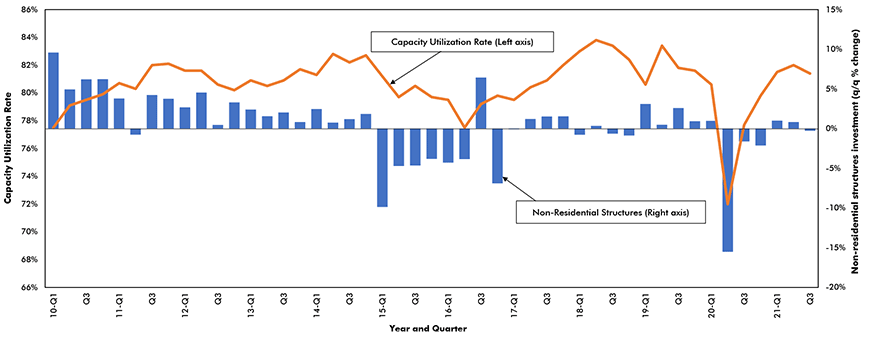Snapshot #5 (Outlook for non-residential investment brightest since 2018) at the beginning of this year spotlighted three forward-looking investment indicators that were pointing higher. First, the Bank of Canada’s (BoC) Winter Business Outlook Survey reported a solid gain in the number of firms planning to boost their investment in machinery and equipment over the next 12 months. Second, the Conference Board of Canada’s Business Index signaled firms were “ready to ramp up their investments in the near term”. Third, Statistics Canada’s Non-Residential Capital and Repair (CAPEX) Survey of 25,000 private and public enterprises reported on their plans to ramp up spending by +7% this year following a -9.2% drop in 2020.
Unfortunately, the picture painted by those indicators has not been as bright as promised. Year-to-date (September) the volume of business gross non-residential fixed capital formation is down by -1.7%. Firms have scaled back their investment plans due to third wave COVID-19 impacts, labour shortages, supply chain issues, and heightened uncertainty about Canada’s regulatory environment.
Investment outlook improved between COVID Waves
As the impact of the third wave of COVID dissipated and we attempted to “look through a glass darkly” at the near-term outlook for capital spending, we were initially encouraged by the results of the . It noted that “firms anticipate stronger demand as pandemic conditions improve”. Supply constraints were viewed as likely to limit sales, but a record number of firms were planning to invest more in machinery and equipment. This upbeat outlook was reinforced by a sustained increase in investor confidence as reflected by the +19% year-to-date increase in the S&P/TSX Composite Index and negative real interest rates.
Near term investment outlook dims
Over the past few weeks, however, several developments have prompted a scaling back in expectations about the strength of the recovery in capital spending. First, the dropped by 19 points in November to 85.6, its lowest value since mid-2020. Factors contributing to this retreat included supply chain issues and the rapid escalation of consumer and producer prices on both sides of the Canada/U.S. border.
Second, after hitting a two-year high of 82.0% in the second quarter, Statistics Canada is reporting that the all-industry capacity utilization rate retreated to 81.4% in the third quarter. This suggests less pressure on firms to increase the size of their physical plant or add new equipment.
Third, the unexpected onset of the Omicron variant of COVID-19 virus has caused several provincial governments to reintroduce measures to limit in-person gatherings.
The fact that employment in Canada in November (19,162 million jobs) was slightly above its pre-pandemic peak in January 2020 (19.151 million) is evidence governments and businesses have coped successfully with the four COVID waves that have swept across the country since March of last year.
Although Omicron is more transmissible than previous variants, it does not appear to cause more severe outcomes, particularly among individuals 18 to 39 years of age. Furthermore, the pre-emptive distribution of booster vaccine shots will likely increase protection against severe infections. Nevertheless, firms will temporarily put some projects on hold until they are better able to gauge the consequences of the Omicron virus.
Labour shortages dampen longer-term investment outlook
The one factor which, in our view, threatens to impede capital investment in Canada over the longer term was recently highlighted by the and by Dr. Jack Mintz, Palmer Chair of Public Policy at the University of Calgary. According to the CFIB, half of Canadian small businesses are experiencing acute shortages of labour, that will be made more acute by an aging population. Dr. Mintz has noted that by the end of this decade, the percentage of the population aged 65 and older will account for 22% of the population, up from 19% in 2019.
The government’s plans to raise the country’s immigration limit will partially offset the impact of the shrinking labour force. Despite this increased intake of permanent residents, however, the shortage of skilled workers in Canada’s construction industry (which has the third-highest job vacancy rate among Canada’s 16 major sectors) will weigh on non-residential industrial and commercial building going forward.
John Clinkard has over 35 years’ experience as an economist in international, national and regional research and analysis with leading financial institutions and media outlets in Canada.
Non-residential investment vs industrial capacity utilization

Chart: ����ӰԺ — CanaData.
Please click on the following link to download the PDF version of this article:









Recent Comments
comments for this post are closed